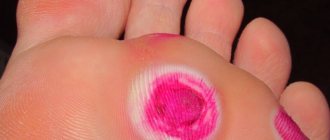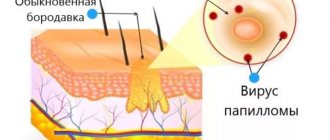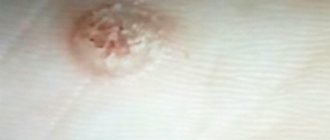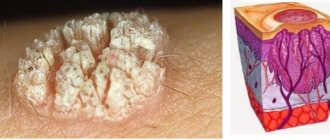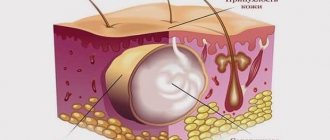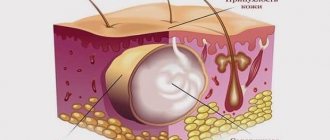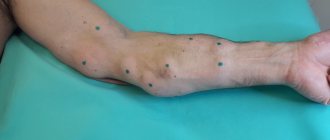Very often, a person may develop formations of a benign type, which cause discomfort and interfere with the normal process of life. One of these problems is the formation of warts, which arise as a result of damage to the skin by the papilloma virus.
One of the most unpleasant formations is the appearance of formations on the soles of the feet. A wart on the sole of the foot is also called a wart; it can cause a lot of discomfort when a person walks.
This type of wart can appear absolutely anywhere on the foot, but most often it occurs on the fold and between the toes. With timely treatment, it goes away quickly, however, if the impact on the area is delayed, the lesion may enter an old stage and require long-term treatment.
Causes of plantar warts
This type of infection can strike a person at any time, however, progression of the disease most often occurs as a result of reduced immunity.
Very often, the occurrence of warts of this type may indicate the presence of a complex disease, therefore, if warts often appear in the area of the sole, it is necessary to undergo appropriate diagnostics.
The appearance of spitz in the area of the soles of the feet can occur for the following reasons:
- Heart disease;
- Disease of the circulatory system;
- Damage to the skin, facilitating the penetration of the papilloma virus into the layers of the epidermis;
- Frequent stressful situations;
- Allergic reactions;
- Malfunctions of the immune system;
- Oncological diseases;
- Diabetes mellitus;
- Improper foot hygiene;
- Wearing uncomfortable shoes, which contributes to the appearance of corns that develop into warts on the feet;
- Walking barefoot in places of high humidity (baths, saunas);
- Increased sweating of the feet
Also, the appearance of warts can be facilitated by frequent hypothermia, which disrupts the normal functioning of the body and manifests itself in the form of skin diseases.
Causes of the disease
The causes of neoplasms on the legs are not fully understood, but it is noted that most often the causative agent of the pathology is the human papillomavirus. It penetrates the body and leads to pathological changes in tissues. Due to the thinness of the skin in the foot area, this area of the body undergoes changes most often.
Infection with the virus occurs from a sick person to a healthy person through contact and household contact. For a long time it remains in the body in a latent form and under certain circumstances is activated. Factors that provoke the development of a viral pathogen in children and adults include the following:
- regular hypothermia of the body;
- frequent stress and nervous tension;
- excessive physical activity on a regular basis;
- weakening of the body’s immune forces due to a lack of vitamins and minerals;
- frequent foot injuries and the presence of small scratches or cracks;
- violation of tissue regeneration;
- Constantly wearing uncomfortable and ill-fitting shoes.
Weakened immunity is the main reason for the development of plantar warts in pregnant women and children.
One of the common reasons is neglect of the rules of personal hygiene, as a result of which pathogenic microorganisms develop on the surface of the skin, causing the appearance of a growth.
Main symptoms
After the human papillomavirus has been introduced into the body, it can remain in an incubation period for up to six months, during which time the person does not feel any changes. The influence of several factors leads to the gradual growth of the tumor. It is at this moment that the first symptoms of pathology appear:
- the affected areas look like small bumps with discolored skin;
- the skin around the tumor may turn red;
- in some cases, swelling is observed at the site of the growth;
- if the tumor has a long root, there is pain when pressing and while walking;
- when growths appear between the fingers, kissing warts form, which are constantly in contact with each other, which leads to injury;
- internal and subcutaneous types of pathology rarely provoke pain and usually have a flat shape.
The localization of growths is different. They can appear on the big toe or little toe, on the foot and between the toes. The intensity of the pain syndrome largely depends on the location of the formation. Children have a hard time enduring the pathology, because due to excessive activity they subject the growth to regular injury.
The most painful are genital warts, which most often form in the area of the external genitalia, but often appear on the legs. They are small in size and pointed in shape, are constantly injured and bleed.
What does a wart on the sole of the foot look like?
A wart on the sole looks like a dense formation of varying sizes in the center with a very pronounced affected area, reminiscent of a callus that has grown into the skin. Painful symptoms most often appear when pressing on the wart and can vary in intensity.
Symptoms of a wart:
- At the site of wart formation, the skin becomes rough and rough;
- When walking, a person may feel sharp pain;
- The stratum corneum increases at the site of the wart;
- The presence of black dots in the center, sometimes itching;
- When the skin is damaged, blood appears at the site of wart formation.
The first signs of a wart may appear as follows:
- The appearance of thickening of the skin, which most often itches and hurts when pressed;
- The skin becomes yellow or brown;
- In the center of the wart, a rod consisting of dead cells appears.
Very often, in the absence of timely treatment, a specific odor appears in the area of the skin lesion, which cannot be eliminated by simply washing the feet.
Photo of what plantar warts look like:
How to distinguish a wart from calluses?
A wart differs from calluses on the feet in the following ways:
- The callus most often has liquid contents;
- A callus has unclear boundaries, while a wart has clear contours;
- The callus goes away quickly within a week.
A wart differs from corns in the following ways:
- When a corn forms, the skin pattern on the surface is preserved;
- Pain with a corns manifests itself throughout the entire area of formation, while a wart manifests itself with painful symptoms in the center;
- Unlike a wart, when the skin is damaged in the area of the corn, no bloody discharge appears.
In the first stages of a skin infection, it is very difficult to distinguish a wart from other types of diseases, so you should contact a specialist who will prescribe the appropriate treatment.
Forecast
The appearance of a plantar wart is not a reason to panic. Many people encounter them. And the prognosis for this disease in most cases is favorable, since the majority of patients succeed in removing plantar warts. You can completely get rid of even multiple and long-existing uncomfortable growths on the feet.
A high risk of relapse and the appearance of multiple growing secondary warty rashes is observed only in people with immunodeficiency conditions. Therefore, they are prescribed complex treatment, including, along with removal of the formation, the use of immunomodulatory and antiviral agents, ozone therapy and even hypnotherapy. This allows you to effectively prevent relapses of the disease.
In addition, more than 30% of plantar warts disappear on their own within a few months, even without the use of radical removal methods. Such spontaneous resolution is usually observed in patients with a sufficiently strong immune response and the absence of underlying dermatological disorders on the feet.
How to remove a plantar wart?
There are a large number of methods for removing warts that allow you to quickly and painlessly remove the formation. When you remove warts on your own, marks remain on the skin, so you should contact a specialist who will offer a choice of treatment methods.
Laser wart removal
Before carrying out the treatment procedure, it is necessary to undergo an appropriate examination to obtain an accurate diagnosis.
Removing plantar warts with a laser has the following advantages:
- The procedure is carried out quite quickly;
- Skin damage resolves quickly;
- There are no scars left after the procedure;
- Before the procedure, the area is anesthetized, which reduces discomfort;
- No relapses;
- Removal occurs in one procedure.
Before removal begins, specialists take the necessary tests and make sure that this type of disease is not malignant. Also, thanks to this type of examination, the required depth of laser exposure in the layers of the epidermis is revealed.
After all the test results have been studied, the specialist proceeds directly to the removal procedure.
The patient is given local anesthesia and a laser beam is used to destroy the wart and root system. Using a laser beam, all cells infected with the virus are removed, thereby achieving a high level of efficiency.
Contraindications to the wart removal method:
- High blood pressure;
- The presence of an infectious lesion of the body, including ARVI;
- Oncological formations;
- Diabetes mellitus.
Removal of formations in childhood with a laser beam is carried out only in case of urgent need. Before the procedure, it is necessary to pass all tests, including checking individual tolerance to anesthesia; this type of removal of formations is not used until 3 years .
After the wart is removed, the patient treats the wound with an antiseptic and applies a sterile bandage; after a few days, the bandage is allowed to be removed. No special method of restorative care is required after this type of procedure for removing warts from the soles of the feet.
The average cost is 3000 rubles .
Liquid nitrogen – cryodestruction
This method of removing a wart from the sole is carried out by freezing the formation and then removing it.
There are the following types of contraindications to this method:
- Individual human reactions to the components of treatment;
- Hypertension;
- Epilepsy;
- Pregnancy period;
- Damage to the body by viral infections.
During the procedure, the specialist applies liquid nitrogen to the damaged area and leaves it for a few seconds until the wart turns white. After the procedure, after some time a blister with liquid will appear on the spot.
This type of symptom confirms that the procedure was successful. The blister will disappear on its own in a few days, leaving a pink spot at the site of the wart.
The advantages of this method of plantar wart removal:
- Availability of the procedure;
- Elimination of further skin damage by the virus;
- No scars.
Disadvantages of the procedure:
- Duration of treatment;
- The appearance of a blister;
- Possibility of getting burned.
After the procedure is completed, it is recommended to change the bandage daily until a crust forms at the site of the blister. After a crust has formed, the damaged area must be sealed with a bactericidal plaster.
It is not recommended to use in children under 7 years of age ; consult a doctor before performing the procedure.
The average cost of the procedure is up to 1000 rubles .
Radio wave radiation
The procedure for eliminating plantar warts is performed using a special device.
The operation of the device is aimed at releasing electric current, which is converted into radio waves. Due to this, damaged wart cells are destroyed. Using a special attachment, the wart is excised without contact with healthy epidermal cells.
The advantages of this type of procedure:
- The depth of wave exposure is regulated by a specialist;
- No burns remain;
- The procedure takes a short time;
- No scars;
- No relapses.
Disadvantages of the procedure:
- The need to use pain relief;
- Possibility of a blister;
- Swelling of soft tissues may occur;
- Possibility of changing skin color immediately after the procedure.
Removing warts on the sole of the foot has the following contraindications:
- The presence of malignant tumors;
- Presence of a pacemaker;
- Infectious lesion of the body;
- The presence of complex diseases of internal organs;
- Herpes on the skin;
- Presence of other skin diseases;
- Menstrual flow in women;
- Childhood.
After removal, the following rehabilitation methods must be followed:
- Until the scab completely disappears, you must wear a sterile bandage;
- Make sure that there is no pressure or friction on the wart removal site; it is recommended to use soft shoes;
- Treat the area where the wart was every day with a special medication prescribed by your doctor;
- If any symptoms of complications appear, such as swelling, discharge, or redness, you should consult a doctor.
The average cost of removal is 2000 -2500 rubles .
Electrocoagulation
With this method of influencing the wart, the cells of the wart are destroyed using current of varying intensity levels.
Removal occurs using a special device, in which, using a special nozzle, the wart is cauterized, damaged cells are destroyed, and the natural process of regeneration of healthy epidermal cells is launched.
Using this type of method for removing warts on the plantar area of the feet has the following advantages:
- The procedure is quick;
- Affordable cost of treatment;
- The skin recovers quickly after exposure to electric current;
- The skin has minor damage.
Among the disadvantages of removal, it should be noted the need to use local anesthesia.
Contraindications to this method:
- Presence of a pacemaker;
- Diseases of internal organs;
- Viral lesions of the body;
- Pregnancy and breastfeeding;
- Advanced age;
- Children's age up to 16 years.
After removal, a scab forms at the site of the wart, which falls off on its own after a few weeks. After which a crust forms on the skin, which is recommended to be treated daily with a special antibacterial agent prescribed by the attending physician.
The average cost of the procedure is from 1000 to 1500 rubles , depending on the size of the wart on the foot.
Surgical removal
Removing a wart from the sole of the foot is therefore done using a scalpel under anesthesia.
Before the procedure, the patient is assigned to undergo a special examination, which will help identify the cause of the disease and choose the right type of anesthesia.
To carry out the method, the patient is given local anesthesia, after which the specialist makes an incision and removes the wart along with the root. After removing the wart, a suture is placed on the wound, which is removed after seven days.
The advantage of this method of eliminating warts of the sole is that it is possible to remove large formations. Which are problematic to eliminate using special equipment.
Disadvantages of this method:
- Scars remain;
- The procedure may take a long time;
- The need to remove stitches;
- After the anesthesia wears off, a painful sensation appears;
- In the first few days, long walking should be avoided;
- Complications may arise.
Surgical removal of warts on the sole of the foot has the following contraindications:
- Diabetes;
- Poor blood clotting;
- Malignant formations;
- Inflammation of the skin at the location of the warts;
- Herpes;
- Pregnancy;
- Children under 14 years of age;
- Infectious lesion of the body.
This method of eliminating warts on the soles of the feet requires compliance with the following rehabilitation rules:
- Once a crust has formed, it should not be removed;
- During the first week, it is necessary to eliminate the possibility of fluid getting into the wound;
- It is prohibited to use any medications unless they have been prescribed by the attending physician;
- Introduce foods rich in vitamins A and E into your diet; this is necessary to speed up wound healing.
If any complications occur, you must contact a medical facility.
The average cost is from 1000 to 2000 rubles , depending on the size and number of warts.
Diagnostics
Usually, to diagnose plantar growths, it is enough to contact a dermatologist and conduct a visual examination.
But sometimes you have to use additional methods:
- To better examine the tumor, the dermatologist carefully scrapes off the upper keratinized scales. The presence of thrombosed capillaries confirms that it is a wart;
- PCR diagnostics detects the presence of papilloma virus;
- An ultrasound may be prescribed to determine the depth of the growth. His data will be needed to select a treatment method;
- sometimes plantar growths resemble manifestations of syphilis. Then an examination for this disease is required.
Such extensive diagnostics are used only in complex cases.
Drug treatment of plantar warts
If necessary, you can remove a wart from the sole of your feet with medication. The action of this method is aimed at improving the resistance of the immune system, due to which the wart is independently removed and its further development is blocked.
The most popular medications include:
- Interferon - used to increase immune resistance to various viral skin lesions, including papillomas. Used twice a day for a course of no more than 10 days. Contraindicated in case of individual sensitivity to the components of the drug and in the presence of mental disorders. Use in childhood is acceptable, however, it requires an individual course of treatment. Average cost 220 rubles ;
- Cycloferon is prescribed to increase the body's resistance to viral damage. Use once a day 20 minutes before meals. The tablet must be taken with plenty of water. The course of treatment is up to 20 days. Depending on the individual characteristics of the body. For children, the use of the drug is allowed upon reaching 3 years of age; the dosage is prescribed on an individual basis. It is contraindicated to use the drug during pregnancy and breastfeeding. Average cost 350 rubles ;
- Viferon - available in the form of suppositories, recommended for enhancing immunity and increasing resistance to various viral infections. Use once a day before bed for 7 days. Allowed for use in children from 1 month. The average cost of the drug is 220 rubles .
Interferon
Cycloferon
Viferon
This method of eliminating warts on the soles of the feet is effective only in the first stages of infection. For more complex stages it must be used in combination with local treatment.
Local treatment of plantar warts
The effect of local drugs is to act on the wart and eliminate unpleasant symptoms.
The most commonly used medications include:
- Salipod - a patch with salicylic ointment produces a softening effect, due to which dead cells are eliminated and the papilloma virus is destroyed. It is recommended to use directly on education for 5 days. Before using the patch, steam the skin with hot water and soda. Apply the patch and leave for the whole day. The average cost of such a drug is 70 rubles ;
- Viferon ointment is a special type of ointment that improves the immune system's resistance to viral infections and promotes rapid regeneration of skin cells. Apply directly to the wart three times a day, the course of treatment is up to 10 days. Allowed for use by children over 4 years old. The average cost of the ointment is 270 rubles ;
- SuperClandestine is a special solution that removes cells damaged by the papilloma virus. When using it, it is necessary to apply it in a dotted manner using a special pipette to the center of the wart. Avoid contact with healthy skin, as it may cause burns. Use once a day for 5 days. The average cost of a medicinal substance is 100 rubles . It has the following contraindications for use: children under 14 years of age;
- individual sensitivity to components;
- pregnancy and breastfeeding;
- presence of a wound;
- presence of birthmarks;
Salipod
Viferon ointment
SuperClandestine
Cryopharma
Feresol
Verrucacid
The use of such drugs may cause side effects such as itching, burning and swelling of the skin. Before use, it is recommended to carefully read the instructions.
Treatment with folk remedies
Very often, traditional medicine methods are used in combination with medications, which help speed up the healing process and reduce unpleasant symptoms.
When using such methods in childhood, it is recommended to consult a pediatrician and conduct a test for individual sensitivity to the components of the drug.
For adults
For people over 18 years of age, the following traditional medicine methods are used to eliminate warts on the soles of the feet:
- Lotions with celandine - in order to make a lotion with celandine, you need to carefully cut a branch of the plant and, using the juice that is released, apply a few drops to the center of the wart and seal it with a band-aid. Apply twice a day for 5 days. It is necessary to carry out the procedure with gloves and make sure that the plant juice does not get on healthy skin, otherwise burns may occur;
- Onion compress with vinegar helps to eliminate damaged epidermal cells and eliminate various types of formations. To prepare a compress, you need to use onions and table vinegar. Pass one medium onion through a meat grinder and add a tablespoon of vinegar. Mix and apply the resulting mixture to the problem area on the sole and attach a plastic film on top. Secure the compress with a bandage and leave overnight. After removing the compress, the leg must be treated with a soap solution. It is recommended to carry out such procedures up to 5 times;
- Rowan compresses - you need to crush the rowan berries to obtain a paste and apply to the wart on the sole, secure with a gauze bandage. Leave this compress overnight, and in the morning, rinse off any remaining product with warm water. The course of treatment is up to 7 days. This method of eliminating formation helps eliminate viral damage and eliminate pain symptoms.
For children
For children, it is recommended to use the following traditional medicine methods:
- Potato compress – fresh potatoes have the ability to eliminate microbes and trigger the skin’s natural regeneration processes. To prepare a compress, you need to chop half the potatoes and apply the resulting mass to the wart on the sole. Secure with adhesive tape and bandage. Use once a day for 5 days. Recommended age over 3 years;
- Dandelion juice - used to eliminate warts from the age of 5 years. For use, it is recommended to apply a few drops of plant juice to the wart on the sole and secure with a band-aid. Apply three times a day for 3 days;
- Lotion with a series - used to eliminate various skin diseases and infections, including the papilloma virus. You need to pour a tablespoon of herb with a glass of boiling water and leave for 30 minutes. Soak a cotton ball in a herbal decoction and apply to the sole, use three times a day for 5 days. Allowed for use from the age of 6 months;
- Onion compress – used for children over 3 years old. To prepare, you need to cut a small onion in half and attach it to the sole using a plaster. This type of compress is done before bed and left overnight. The course of treatment is no more than 4 days.
The use of traditional medicine methods is effective when the first signs of disease appear on the soles of the feet, and require regular implementation.
Garlic
Treatment of warts on the foot at home can be done using garlic. The vegetable is filled with phytoncides, which reduce the activity of the virus, dry out growths and permanently relieve relapses of the disease.
- The easiest way is to use applications on a sore spot. A peeled clove of garlic should be cut into slices and one should be applied to the wart. Cover the top with a bandage, secure the bandage and do not remove it for 2-3 hours.
- To make the procedure more effective, it is recommended to soak peeled garlic overnight in apple cider vinegar. Take it out in the morning, cut it and make an applique.
- It is easy to remove plantar warts with a garlic tortilla . This is a proven folk remedy. You need to chop 2 cloves, add 1 teaspoon of rye flour to them and mix thoroughly. You should get a thick dough-like mass. You need to form a cake out of it and attach it to the wart. After 8 hours, remove the compress, wash the skin and put on socks. If you use the lozenge daily, after 2-3 weeks the growth will no longer cause discomfort.
- Natural honey is useful for treating growths on the feet. It should be mixed with garlic juice in a ratio of 1:3 and lubricate the affected areas of the skin with the healing liquid before going to bed.
- An old folk recipe provides quick removal of warts. You should bake a head of garlic in the oven. Peel off the husks and mash with a fork. Combine with the same amount of soft butter and beat. Thickly coat the bandage with garlic ointment and apply to the skin overnight. After a week, the wart will turn black and fall off.
Prevention
In order to avoid the occurrence of diseases such as warts on the soles of the feet, simple preventive measures should be followed:
- Regularly saturate the body with beneficial vitamins and microelements that will strengthen the immune system to fight viral damage;
- Eliminate corns and calluses on the soles of the feet in a timely manner;
- If damage to the skin occurs on the sole, the scratches should be treated with an antibacterial agent;
- Avoid walking barefoot in public areas;
- Have individual personal hygiene items;
- Maintain proper foot hygiene; in case of increased sweating, use special preparations to improve the functioning of the sweat glands.
Following simple prevention methods can prevent the development of an unpleasant disease on the soles of the feet.
